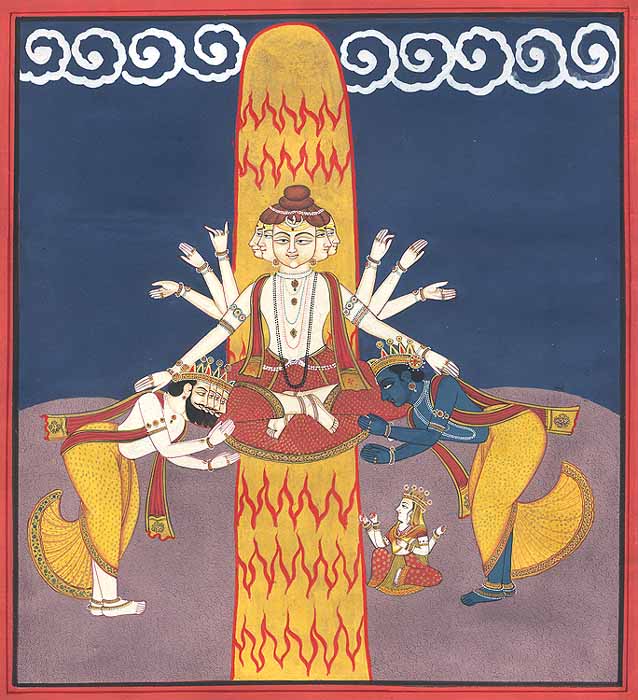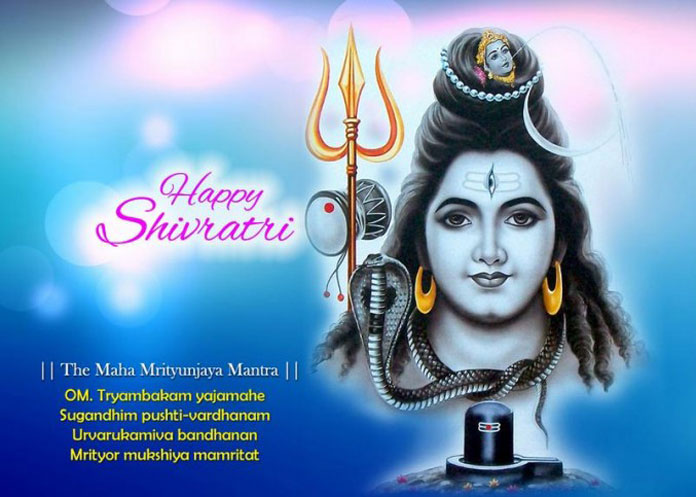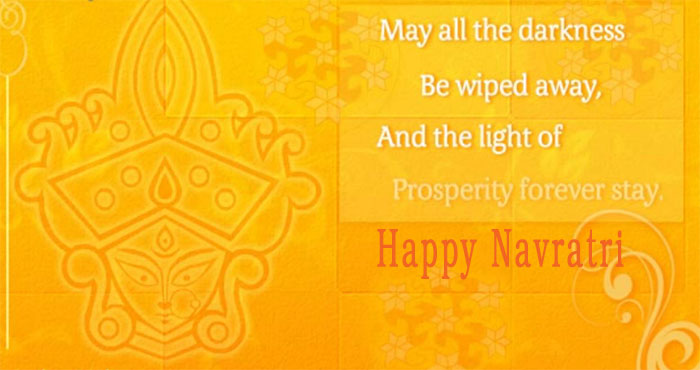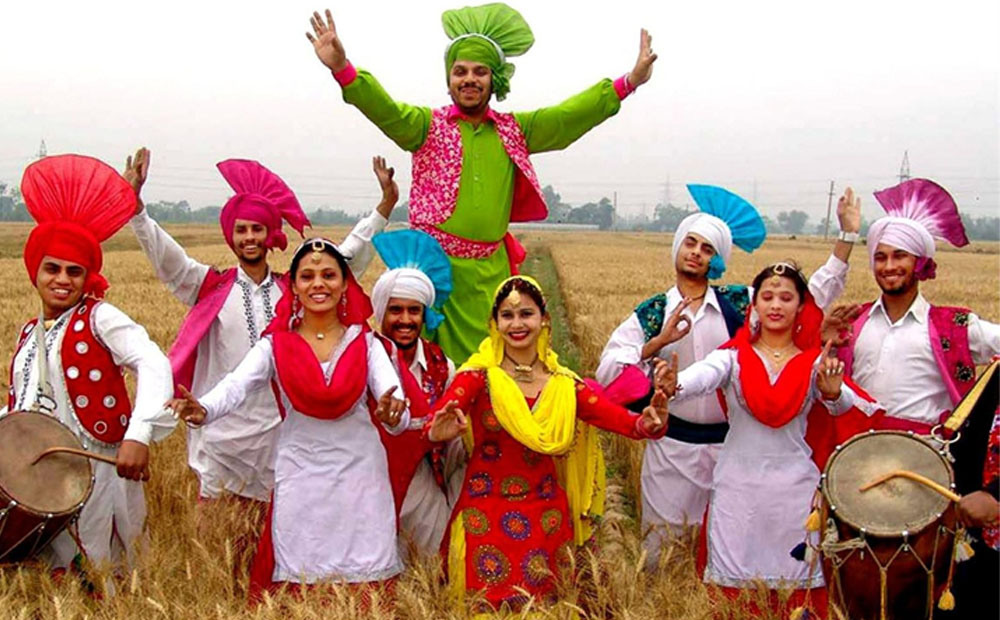Mahashivartri celebrates the Lord of the lords, the mightiest of all Gods – Shiva. ‘We conceive God as glory, as creativity and as austerity. Vishnu is glory and magnificence; Brahma is creativity force; and Siva is austerity and renunciation’ as explained by Swami Krishnananda
Mahashivratri is celebrated as the convergence of the forces of Shiva and Shakti between the 13th night and the 14th day of the Hindu calendar month of Phalguna or Maagh, with offerings of Bael leaves to Shiva, all-day fasting and an all-night-vigil (jagaran). All through the day and night, devotees chant “Om Namah Shivaya”, the sacred mantra of Shiva. Penances are performed in order to gain boons in the practice of Yoga and meditation, in order to reach life’s highest good steadily and swiftly. On this day, the planetary positions in the Northern hemisphere act as potent catalysts to help a person raise his or her spiritual energy more easily. The benefits of powerful ancient Sanskrit mantras such as Maha Mrityunjaya Mantra increase greatly on this night.
Date and Puja Timings of Mahashivratri 2025, Jakarta:
This year Mahashivratri would be celebrated on Wednesday, February 26, 2025.
Nishita Kaal Puja Time – 11:42 PM to 12:29 AM, Feb 27
On 27th Feb, Shivaratri Parana Time – 05:58 AM to 10:24 AM
Ratri First Prahar Puja Time – 06:13 PM to 09:09 PM
Ratri Second Prahar Puja Time – 09:09 PM to 12:05 AM, Feb 27
Ratri Third Prahar Puja Time – 12:05 AM to 03:02 AM, Feb 27
Ratri Fourth Prahar Puja Time – 03:02 AM to 05:58 AM, Feb 27
Chaturdashi Tithi Begins – 12:38 PM on Feb 26, 2025
Chaturdashi Tithi Ends – 10:24 AM on Feb 27, 2025
MahaShivratri is a solemn festival marked with internal reflection and introspection. In Shaivism, it is said that on this night, Lord Shiva had performed the hypnotic and heavenly dance of creation, preservation and destruction. Other legends say that on this night, Shiva and Shakti had got married. The origin of Shivaratri is attributed to several stories in Hindu mythology and Puranas describing the origin of this festival.
Another story is of the churning of the ocean of milk or the samudra manthan, a pot of poison emerged from the ocean. This terrified the Gods and demons as the poison was capable of destroying the entire world, and they ran to Shiva for help. To protect the world from its evil effects, Shiva drank the deathly poison but held it in his throat instead of swallowing it. This made his throat turn blue, and he was given the name Neelakantha, the blue-throated one. Shivaratri is the celebration of this event by which Shiva saved the world.
The learning and philosophical essence of the above myth is that gods and demons symbolize the different people (both good and bad) in the world. The Ocean of Milk represents the ideal world that is full of peace and happiness for all humanity. Churning the Ocean of Milk signifies the human activity in the world. The amrita or nectar symbolizes happiness and the poison represents human greed and selfishness. Shiva symbolizes the atman (self), the spiritual essence of an individual. Worship of Shiva denotes meditation and contemplation by an individual on his or her own self.

Yet another legend in the Shiva Purana is about the Hindu Gods – Brahma and Vishnu, were fighting over who was the superior of the two. Horrified at the intensity of the battle, the other gods asked Shiva to intervene. To make them realize the futility of their fight, Shiva assumed the form of a huge column of fire in between Brahma and Vishnu. Awestruck by its magnitude, they decided to find one end each to establish supremacy over the other. Brahma assumed the form of a swan and went upwards and Vishnu as Varaha went into the earth. But light has no limit and though they searched for thousands of miles, neither could find the end. On his journey upwards, Brahma came across a Ketaki flower wafting down slowly. When asked where she had come from, the Ketaki replied that she had been placed at the top of the fiery column as an offering. Unable to find the uppermost limit, Brahma decided to end his search and take the flower as a witness.
At this, the angry Shiva revealed his true form. He punished Brahma for telling a lie, and cursed him that no one would ever pray to him. The Ketaki flower too was banned from being used as an offering for any worship, as she had testified falsely. Since it was on the 14th day in the dark half of the month of Phalguna that Shiva first manifested himself in the form of a Linga, the day is especially auspicious and is celebrated as Mahashivaratri. Worshipping Shiva on this day is believed to bestow one with happiness and prosperity.
Mahashivaratri is thus not only a ritual but also a cosmic definition of the Hindu universe. It dispels ignorance, emanates the light of knowledge, makes one aware of the universe, ushers in the spring after the cold and dry winter, and invokes the supreme power to take cognizance of the beings that were created by Him.
Mahashivaratri Puja Vidhi
- Take bath before doing Puja or visiting a temple.
- Sprinkle Gangajal on the Puja area.
- Light a brass or earthen lamp.
- Sit down with your eyes close and invite Lord Shiva to accept your offerings.
- Now, do abhishek with water on Shiv Linga or Shiva’s Moorti.
- Then do Abhishek with Milk, Dahi, followed by Honey, Ghee (clarified butter) and water again.
- Chant ‘OM’ or ‘OM Namah Shivaya’ while doing the Abhishek.
- Use a fresh piece of cloth of gently wipe the Shiv Linga or Idol.
- Use the sacred ash (Vibhuti) or bhasm and make a Tripundra on the Lord’s Forehead or on the Shiv Linga. (The Tripundra is the three famous horizontal marks). Put a Chandan Ka tika in the centre of the horizontal line in the middle. And then add kumkum ka teeka. Add Bael or Vilva leaves and flowers.
- Light incense sticks and dhoop.
- Then offer fruits and dry fruits to the God.
- Then chant the Shiva Chalisa or the 108 names of Lord Shiva or any simple Shiva Mantra.
- Meditate for a while.
- Then sing the Shiva Aarti.








